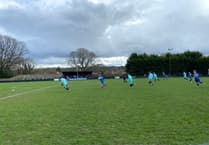THERE aren’t many people in Farnham who haven’t tried their hand at the sport of tennis at some stage in their lives, maybe at school, with family or friends or with a club.
And, for the record, there are probably more facilities for tennis dotted around the town and our local villages than just about any other sport. Culturally and historically, it’s been a notable activity for our town.
What we now call the game of tennis took about a millennium to evolve into the game we know today.
Although there is some evidence early forms of tennis were played in ancient Egypt, Greece and Rome, most historians of tennis agree the sport originated in French monasteries somewhere around the year 1000.
The monks played a game called jeu de paume (‘game of the hand’) in which they used their hand to hit a wooden ball over a rope stretched across the courtyard.
Historians believe the name ‘tennis’ came from the French term tenez, meaning ‘take this!’ During the game, the monks would shout ‘tenez’ as they served the ball.
Over the next few hundred years, the game spread throughout Europe, becoming extremely popular with the nobility. It was especially popular in France.
By the 13th century, the sport had moved inside and was played with bouncier, leather balls and a paddle with webbing. Those were the early types of rackets, nothing like their sophisticated modern counterparts, the design of which started to slowly evolve from around the 16th century.
The game soon came to England where Henry VII and Henry VIII played and directed the building of courts throughout the country. The one constructed in Hampton Court Palace in 1625 is still used today.
No-one is entirely sure where tennis scoring – love, 15, 30, 40 – came from.
Some point to an old Italian ball game called Pallone but most sources agree it originated in France.
One theory for the origin of the 60-point system is it’s simply based on the number 60, which had positive connotations in medieval numerology. The 60 was then divided into four segments.
However, the more popular explanation is the scoring was invented to match the face of a clock with the score given in quarter-hours: 15, 30, 45 (shortened to the French for 40 quarante, rather than the longer quarante cinq for 45).
It wasn’t necessary to use 60 because reaching the hour meant the game was over anyway – unless it was tied at ‘deuce’.
That term probably derives from the French for deux, or just two points away from the end. Similarly, the term ‘love’ is likely to derive from the French word l’oeuf, or ‘egg’, a symbol of nought, like a goose egg.
First played in 1877, the Wimbledon Championship is the oldest tennis tournament in the world and the first of the four Grand Slam events.
The US Open was founded in 1881, the French Open in 1891 and the Australian Open in 1905.
Though none is quite as old as Wimbledon, there are good number of outstanding, well-established tennis clubs in Farnham, including the Bourne Club which has indoor and outdoor courts and, outdoors only, there’s the Brightwell Tennis Club and several other active clubs on the recreations grounds at Wrecclesham, Rowledge, The Bourne Green and Badshot Lea.
The relatively new-to-the-scene David Lloyd Club has outdoor courts and a tennis dome for the winter months.
Many of the surrounding villages to Farnham also have superior tennis clubs. For sure, thanks to generations of fantastic volunteers and good coaches, it’s been a well-organised and popular sport for all ages and abilities in Farnham.
Let’s hope the joy and the sound of tennis comes back soon – we even miss the grunting and screaming.




